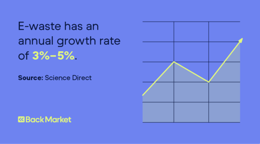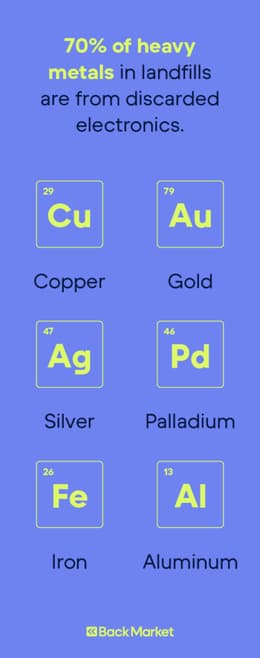
Explore these 40 unbelievable e-waste stats and facts and learn how to reduce e-waste and digital pollution.
Each household in the United States has an average of 21 electronic devices. Many of those devices will become electronic waste, decaying in landfills, jeopardising the health of our planet and ourselves. Sadly, it’s a global problem that’s getting worse every day. Let’s explore digital pollution, electronic waste statistics, and what we can do to protect the planet.
Key takeaways
To emphasise sustainability and responsible consumption, 27% of people opt for refurbished tech.
The global volume of electronic waste, or e-waste, is staggering, with over 347 metric tons of e-waste on Earth in 2024 and a growth rate of 3%-5% annually.
In 2021 alone, the world generated 57.4 million tons of e-waste.
Opting for refurbished electronic devices can significantly reduce the environmental impact of e-waste.
By extending the lifespan of our electronics through reuse and refurbishment, we can positively impact the environment and reduce our carbon footprint.
What is e-waste?
Electronic waste, or e-waste, refers to any unwanted, non-functional, or obsolete electronic device.
Common e-waste equipment includes:
Computers (laptops, desktops, and tablets)
Computer accessories (monitors, smart displays, and printers)
IT and telecommunication equipment (servers, routers, and switches)
Mobile phones (smartphones, feature phones, and traditional telephones)
Televisions (LED, OLED, LCD, CRT tube, or plasma)
Home entertainment systems (DVD players, VCRs, Blu-ray players, and radios)
Home appliances (refrigerators, microwaves, vacuums, and air conditioning units)
Fluorescent lamps
Gaming consoles
E-waste often contains hazardous materials that pose serious environmental and health hazards if not repurposed, recycled, or disposed of appropriately. Improper treatment of this electronic graveyard can unleash a toxic cocktail of various chemicals and neurotoxins, including lead, mercury, arsenic, and brominated flame retardants.
What is e-waste?

General e-waste statistics and facts
So, how much e-waste is produced each year? Spoiler alert: It’s a lot. Let’s start with a few general e-waste statistics that underscore the urgency of adopting responsible e-waste management practices.
42% of people perceive tech as the industry most impactful to the environment. (Back Market)
More than 347 metric tons of unrecycled e-waste are on Earth in 2024. (The Roundup)
E-waste has an annual growth rate of 3%-5%. (Science Direct)
Only 17.4% of e-waste is properly recycled. (The Roundup)
E-waste contains up to 60 different types of heavy metals, including gold, silver, copper, and aluminium. (Science Direct)
Producing just one computer consumes 239kg of fossil fuel, 22kg of chemicals, and 1.5 tons of water. (Athens Journal of Business and Economics)
The value of recyclable resources in e-waste is almost $57 billion. (Science Direct)

Global e-waste facts and statistics
E-waste and digital pollution continue to grow as technology evolves. Trading in your device can help the planet — but when it’s time for people to update their devices, their old tech often ends up in the trash heap. Here are some global electronic waste facts.
As a consequence of e-waste, 58% of the population expresses alarm or concern about climate change. (Back Market)
The total amount of e-waste produced to date is an estimated 420.3 million metric tonnes as of 2024. (The Roundup)
In 2019, the world produced an estimated 53.6 million tonnes of e-waste, but only 17.4% was formally collected and recycled. (World Health Organization)
In 2021 alone, 57.4 million metric tonnes of e-waste was generated globally. (The Roundup)
China, the United States, and India produce the most e-waste. (The Roundup)
The global per capita e-waste generation was 7.3 kg/person in 2019. (Statista)
The countries that produced the most e-waste in 2019 were Asia (24.9 MT), the Americas (13.1 MT), Europe (12.0 MT), Africa (2.9 MT), and Oceania (0.7 MT). (Science Direct)
Only 78 countries have e-waste legislation. (The Roundup)
The Agbogbloshie dump in Ghana receives an estimated 250,000 tons of classified electrical and electronic waste every year. (Science Direct)
The bulk of e-waste produced globally is diverted to landfills. (United Nations Environment Programme)
China generates 74% of the total e-waste in Eastern Asia. (Athens Journal of Business and Economics)
We’re expected to produce 81.6 million tons of e-waste per year by 2030. (World Economic Forum)
Only 17.4% of e-waste is properly recycled worldwide. (World Economic Forum)
By 2030, the total amount of e-waste will be 74.7 million tons, and the amount per person will be 9kg. (Science News)
The amount of e-waste is growing by an average of 2 metric tons per year. (The Roundup)

US e-waste statistics
The problem is even in our own backyard. Here are a few US e-waste statistics.
The social and environmental impact caused by the production of new tech devices is on the radar of 43% of people surveyed in the US. (Back Market)
The social and environmental impact caused by the production of new tech devices is on the radar of 43% of people surveyed in the US. (Back Market)
Eco-anxiety about climate change and other environmental challenges affects 72% of Americans. (Back Market)
The United States generates about 6.9 million tons of e-waste per year. (PIRG.org)
In 2019, only 15% of e-waste was recycled in North America. (Statista)
Discarded electronics make up an estimated 70% of heavy metals in US landfills. (EPA)
Americans threw away 151 million phones (or 416,000 cell phones per day) in 2014. (Earth911)
The United States has more than 2000 companies that treat e-waste. (Science Direct)
48% of people in the US recycle their old tech. (Back Market)

E-waste stats that prove choosing refurbished devices helps the planet
Our electronic devices play an essential role in our daily lives, bridging the gap between work and play. Rather than chucking out used tech, we have the power to make a difference with sustainability efforts.
Younger generations are opting for refurbished technology, with 30% of 16 to 24-year-olds and 31% of 25 to 34-year-olds changing their consumption habits. (Back Market)
Lack of awareness plays a role in the consumption habits of tech products, with 27% of people saying they don’t know how to choose more sustainable options. (Back Market)
Education about finding eco-friendly tech options is an issue, with 18% of people saying they don’t know where to buy more sustainable products. (Back Market)
Smartphones or laptops being good for the planet is important to 68% of people. (Back Market)
Not having the latest smartphone or laptop makes 14% of people feel embarrassed. (Back Market)

Even with resource-heavy replacement parts, like batteries, a study by ADEME shows that refurbished tech can be a significant part of the solution. And with 5 billion smartphones thrown away in 2022, we’ve already extracted more than enough material from the planet to refurbish countless devices.
A refurbished smartphone uses 91.3% fewer raw materials, 86.4% less water, generates 89% less e-waste, and puts 91.6% less carbon emissions into our atmosphere than a brand-new one. (ADEME)
A refurbished iPad uses 99.2% fewer raw materials, 99.9% less water, generates 83.3% less e-waste, and puts 88.1% less carbon emissions into our atmosphere than a brand-new one. (ADEME)
A refurbished laptop uses 95.8% fewer raw materials, 97.3% less water, generates 89.7% less e-waste, and puts 88.9% fewer carbon emissions into our atmosphere than a brand-new one. (ADEME)
A refurbished desktop computer uses 89.7% fewer raw materials, 98% less water, generates 99.6% less e-waste, and puts 89.7% less carbon emissions into our atmosphere compared to brand new. (ADEME)
The percentage of all refurbished tech shows the use of 94.1% fewer raw materials, 94.5% less water, generates 92.6% less e-waste, and puts 89.6% less carbon emissions into our atmosphere than brand-new tech. (ADEME)

By extending the lifespan of our devices through reuse and refurbishment, we not only maximise their utility but also alleviate the environmental burden associated with electronic waste. Choosing refurbished over new tech, like smartphones, tablets, laptops and desktops can significantly reduce carbon emissions and your carbon footprint.
So, let’s remember: The longer we use our devices, the better it is for the planet. Let’s make choices — like trading in our devices — that positively impact the environment in our everyday lives.
Frequently asked questions
Methodologies
Here are the methodologies of the ADEME and Ispos on behalf of Back Market reports, explained.
ADEME methodology
The 2022 ADEME report was conducted using the Life-Cycle Assessment (LCA) methodology, also referred to as Life Cycle Analysis.
LCA methodology assesses the environmental impact of a product, process, or service by examining all stages of the life cycle. It’s considered a holistic approach. In this case, LCA methodology was applied to laptops, desktop computers, smartphones, and tablets, evaluating the entire value chain of a device from new to refurbished.
Factors evaluated for new devices:
Raw materials and their extraction
Component production
Upstream transport
Manufacturing process
Production of packaging and accessories
Distribution
Use
End-of-life (incineration or landfill disposal)
Factors evaluated for refurbished devices:
Collection of used devices
Manufacturing of spare parts
Destruction of used spare parts
Production of packaging and accessories
Shipping
These factors were evaluated on a global scale, making this data applicable worldwide.
Back Market and Ipsos methodology
Ipsos conducted a survey on behalf of Back Market to get an overview of consumer technology and consumption habits. The study aimed to identify broader patterns
and trends in demographic and attitudinal behavior in 5 countries: Spain, France, Germany, the UK, and the US.
Target
The general public, between the ages of 16-74 years old, selected using the quota method
A representative sample of the population of each country (criteria and sources based on official national data: gender, age and socioeconomic category)
Data collection
Sample achieved: 2,000 interviews per country (10,001 interviews in total)
Online (CAWI): from the online Ipsos panels
Questionnaire length: 15 min (15-20 questions)
Master questionnaire in English translated in 3 languages, French, Spanish and German
Working with a partner translation agency
Translated questionnaires reviewed by our colleagues from each country surveyed
Statistical analysis
Weighting (method: Rim Weighting)
Based on official national data: gender, age, region and socioeconomic category
Sourcing
Theroundup.org. “Latest Global E-Waste Statistics And What They Tell Us.” Accessed February 23, 2024.
ScienceDirect.com. “A global perspective on e-waste recycling.” Accessed February 23, 2024.
Athens Journal of Business and Economics. “E-waste Awareness Among Young Generation.” Accessed February 23, 2024.
World Health Organization. “Electronic waste (e-waste).” Accessed February 23, 2024.
Statista.com. “Projected electronic waste generation worldwide per capita from 2019 to 2030 (in kilograms per capita).” Accessed February 23, 2024.
Unep.org. “UN report: Time to seize opportunity, tackle challenge of e-waste.” Accessed February 23, 2024.
Weforum.org. “This year’s e-waste to outweigh Great Wall of China.” Accessed February 23, 2024.
Science News. “Earth’s annual e-waste could grow to 75 million metric tons by 2030.” Accessed February 23, 2024.
PIRG.org. “Repair saves families big.” Accessed February 23, 2024.
Statista.com. “Share of e-waste in the Americas documented to be collected and properly recycled in 2019, by sub region.” Accessed February 23, 2024.
EPA.gov. “Multiple Actions Taken to Address Electronic Waste, But EPA Needs to Provide Clear National Direction.” Accessed February 23, 2024.
Earth911. “20 Staggering E-Waste Facts in 2021.” Accessed February 23, 2024.
ADEME.fr. “Assessment of the environmental impact of a set of refurbished products.” Accessed February 23, 2024.







